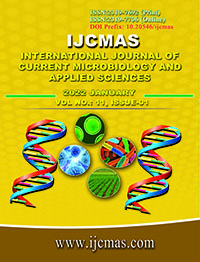


 National Academy of Agricultural Sciences (NAAS)
National Academy of Agricultural Sciences (NAAS)

|
PRINT ISSN : 2319-7692
Online ISSN : 2319-7706 Issues : 12 per year Publisher : Excellent Publishers Email : editorijcmas@gmail.com / submit@ijcmas.com Editor-in-chief: Dr.M.Prakash Index Copernicus ICV 2018: 95.39 NAAS RATING 2020: 5.38 |
Trichoderma spp. are the most commonly used and widely applied biocontrol agents which is known for its antagonistic activities against plant pathogens especially soil borne pathogens such as Fusarium spp. (Fusarium wilt), Rhizoctonia, Pythium (Damping off), Sclerotium rolfsii (Sclerotinia rot), etc. Trichoderma exhibit diverse array of activities viz. plant growth promotion, biofertilizer, bioagents through the production of different biocontrol mechanisms (enzymes) such as chitinase, protease, glucanase, etc. Their mode of action is either by parasitizing the plant pathogens, secreting antibiotics or by competing for space and nutrients. Nutrient uptake is also enhanced as it regulates the root architecture promoting better root growth. Recently studies have found that it can also be utilized for bioremediation which will play a pivotal role in rejuvenating the environment from toxic substances. Heavy metal contaminants like Ni, Cd, Zn, Pb, As has been tolerated and accumulated by Trichoderma sp. Decomposition rate was fastened when Trichoderma was inoculated in agricultural waste substrate. It can detoxify toxic pesticides and fungicides which will be of great help in solving the environment pollutants besides increasing the soil fertility. Its role as biocontrol and as bioremediation can be of great advantage to the agriculture sector in solving disease problems and providing safe environment.
 |
 |
 |
 |
 |